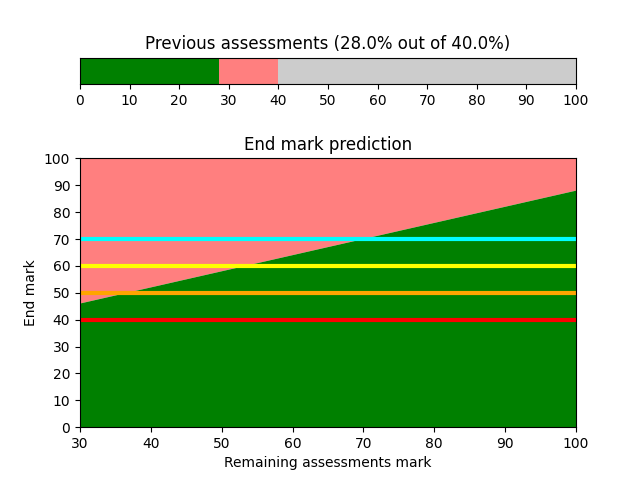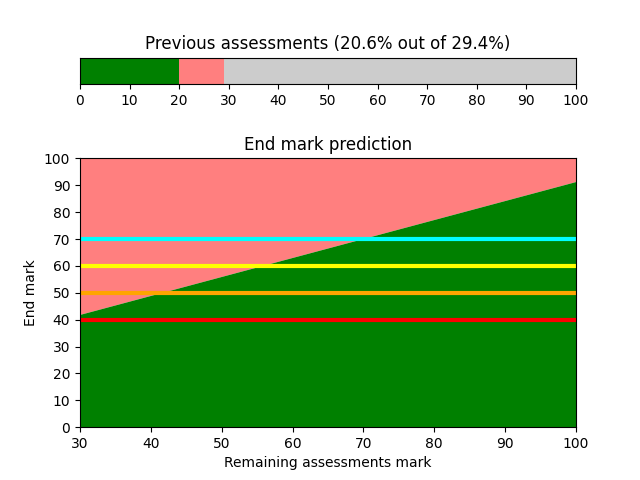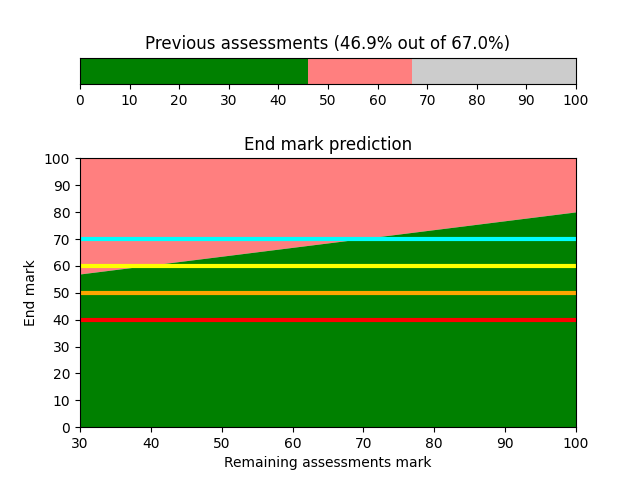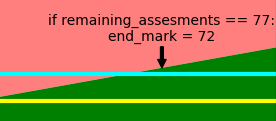Marks calculator. Basing on previous marks it calculates what mark you need to get in remaining assessments in order to get desired end mark.
It can be used to calculate:
- module mark
- year mark
- whole degree mark
Supply marks achieved for past assessments by modifying previous_marks list in the marks.py, and then run it with python. See Usage examples section. Mouse can be used to check exact values at given horizontal position:
Python 3.7 (or later) with the following libraries:
- matplotlib
- numpy
- tkinter
These libraries can be installed by executing the following command:
python3 -m pip install matplotlib numpy tk
3 examples below show how to modify the previous_marks list/section of the marks.py code. All examples assume that the student achieved 70% from every past assessment.
In example below it is assumed that the student completed 2 assessments so far, each being worth 20% of the whole module. Remaining 60% could be an exam or several smaller percentage assessments, it does not really matter.
previous_marks = [
# Format: (mark, weight)
(70, 20), # e.g. first assignment/test
(70, 20) # e.g. second assignment/test
]This example would result in the following output:

The graph tells that even if the student received 100% in all remaining assessments, his mark end/total mark would be ~87%, if in all remaining assessments he got 30%, his end/total mark would be ~46%.
In example below it is assumed that the student has 8 modules.
M_WEIGHT = 100 / 8 # weight of a single module
previous_marks = [
# Format: (mark, weight)
# finished modules marks
(70, M_WEIGHT), # Whole finished module
(70, M_WEIGHT), # Another finished module
# unfinished modules marks
(70, M_WEIGHT * 0.2), # Assessment worth 20% of some unfinished module
(70, M_WEIGHT * 0.15) # Assessment worth 15% of some unfinished module
]The graph tells that even if the student received 100% in all remaining assessments, his mark end/total mark would be ~91%, if in all remaining assessments he got 30%, his end/total mark would be ~41%.
This example would result in the following output:

In example below it is assumed that second year of a degree was worth 40%, 3rd year was worth 60% and that there were 8 modules in the 3rd year. It is also assumed that the 1st year doesn't count towards the overall degree mark.
SECOND_YEAR_WEIGHT = 40
M_WEIGHT = 60 / 8 # single module weight (in 3rd year)
previous_marks = [
# Format: (mark, weight)
# 2nd year overall mark
(70, SECOND_YEAR_WEIGHT),
# total module marks
(70, M_WEIGHT), # Some module final mark
(70, M_WEIGHT), # Another module final mark
(70, M_WEIGHT), # And another module final mark
# module marks with some assessments unmarked yet
(70, M_WEIGHT * 0.06), # Assessment worth 6% of some unfinished module
(70, M_WEIGHT * 0.12), # Assessment worth 12% of some unfinished module
(70, M_WEIGHT * 0.12), # Assessment worth 12% of some unfinished module
(70, M_WEIGHT * 0.1), # Assessment worth 10% of some unfinished module
(70, M_WEIGHT * 0.2), # Assessment worth 20% of some unfinished module
] This example would result in the following output:

The graph tells that even if the student received 100% in all remaining assessments, his mark end/total mark would be ~79%, if in all remaining assessments he got 30%, his end/total mark would be ~56%.
